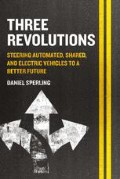Abstract
We love our cars. Or at least we love the freedom, flexibility, convenience, and comfort they offer. That love affair has been clear and unchallenged since the advent of the Model T a century ago. No longer. Now the privately owned, human-driven, gasoline-powered automobile is being attacked from many directions, with change threatening to upend travel and transportation as we know it. The businesses of car making and transit supply—never mind taxis, road building, and highway funding—are about to be disrupted. And with this disruption will come a transformation of our lifestyles. The signs are all around us.
We must steer oncoming innovations toward the public interest—toward shared, electric, automated vehicles. If we don’t, we risk creating a nightmare.
Notes
- 1.
Paul Barter, “‘Cars Are Parked 95% of the Time.’ Let’s Check!,” Reinventing Parking, 22 February 2013.
- 2.
US Department of Transportation, National Transportation Statistics, Table 1–40, updated April 2017.
- 3.
These figures are based on fifteen thousand miles of travel per year. AAA, “Your Driving Costs,” AAA NewsRoom, 23 August 2017; US Department of Labor, 2015 Consumer Expenditure Survey, Table 1203.
- 4.
National Safety Council, “NSC Motor Vehicle Fatality Estimates,” 2017.
- 5.
US Energy Information Administration, “Petroleum and Other Liquids, U.S. Weekly Product Supplied,” accessed 3 September 2017.
- 6.
US Energy Information Administration, “U.S. Energy-Related Carbon Dioxide Emissions, 2015,” March 2017.
- 7.
“Singapore: Intelligent Transport System,” C40 Cities, 2013; Brian Fung, “Here’s One Place in the World You Can Already Hail a Driverless Taxi,” Washington Post, 25 August 2016.
- 8.
Jha Alok, “Delhi’s Air Pollution Is Causing a Health Crisis: So, What Can Be Done?” The Guardian, 3 November 2015.
- 9.
Sharon Silke Carty, “How Humans Could Ruin the Autonomous Era,” Automotive News, 24 October 2016.
- 10.
Chinese sales of new-energy vehicles in 2016 totaled 507,000, consisting of 409,000 all-electric vehicles and 98,000 plug-in hybrid vehicles (many of these trucks and buses), according to Liu Wanxiang, “中汽协: 2016年新能源汽车产销量均超50万辆,同比增速约50%” [China Auto Association: 2016 New Energy Vehicle Production and Sales Were over 500,000, an Increase of About 50%], D1EV, accessed 12 January 2017.
- 11.
International Energy Agency, Global EV Outlook 2017 (Paris, France: OECD/IEA, 2017).
- 12.
European Alternative Fuels Observatory, “Norway,” accessed 4 September 2017.
- 13.
John Zimmer, “The Third Transportation Revolution: Lyft’s Vision for the Next Ten Years and Beyond,” Medium, 18 September 2016.
- 14.
The cost per mile for an electric automated vehicle operated fifty thousand miles or more per year was calculated to be about the same as for a gasoline-powered AV, with the higher up-front costs offset by the lower operating costs (for maintenance and energy). See following note.
- 15.
These numbers are based on a cost analysis of automated and pooled cars done by Aditi Meshram and Daniel Sperling of the Institute of Transportation Studies, University of California, Davis, based on numbers from the Internal Revenue Service, the BLS Consumer Expenditure Survey, APTA’s 2016 Public Transportation Fact Book, and unpublished sources. For transit costs, see chapter 5.
- 16.
T. S. Stephens et al., “Estimated Bounds and Important Factors for Fuel Use and Consumer Costs of Connected and Automated Vehicles,” US Department of Energy, National Renewable Energy Laboratory, Technical Report NREL/TP-5400-67216, November 2016.
- 17.
José Viegas, Luis Martinez, and Philippe Crist, “Shared Mobility: Innovation for Liveable Cities,” International Transport Forum Corporate Partnership Board, 2016.
- 18.
Zia Wadud, Don Mackenzie, and Paul N. Leiby, “Help or Hindrance? The Travel, Energy, and Carbon Impacts of Highly Automated Vehicles,” Transportation Research Part A 86 (April 2016): 1–18.
- 19.
Daniel Fagnant and Kara Kockelman, “The Travel and Environmental Implications of Shared Autonomous Vehicles, Using Agent-Based Model Scenarios,” Transportation Research Part C 40 (2014): 1–13.
- 20.
Lew Fulton, Jacob Mason, and Dominique Meroux, “Three Revolutions in Urban Transportation,” Institute of Transportation Studies, University of California, Davis, Research Report UCD-ITS-RR-17-03, 2017.
- 21.
Brian D. Taylor and Rebecca Kalauskas, “Addressing Equity in Political Debates over Road Pricing: Lessons from Recent Projects,” Transportation Research Record 2187 (2010): 44–52.
Editor information
Editors and Affiliations
Rights and permissions
Copyright information
© 2018 Daniel Sperling
About this chapter
Cite this chapter
Sperling, D., Pike, S., Chase, R. (2018). Will the Transportation Revolutions Improve Our Lives—or Make Them Worse?. In: Sperling, D. (eds) Three Revolutions. Island Press, Washington, DC. https://doi.org/10.5822/978-1-61091-906-7_1
Download citation
DOI: https://doi.org/10.5822/978-1-61091-906-7_1
Publisher Name: Island Press, Washington, DC
Print ISBN: 978-1-61091-983-8
Online ISBN: 978-1-61091-906-7
eBook Packages: EngineeringEngineering (R0)

